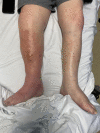Ruxolitinib-Associated Phaeohyphomycosis: A Case Report
- PMID: 34765385
- PMCID: PMC8575341
- DOI: 10.7759/cureus.19335
Ruxolitinib-Associated Phaeohyphomycosis: A Case Report
Abstract
We present the findings of a rare fungal infection phaeohyphomycosis caused by Pleurostoma richardsiae (P. richardsiae) in an immunocompromised 82-year-old male with myelodysplastic syndrome on treatment with the Janus kinase inhibitor ruxolitinib. Hematologists, infectious disease physicians, and surgeons should consider a fungal etiology in cases of cellulitis refractory to standard treatments in those patients with underlying immune dysfunction and/or in those receiving therapy with ruxolitinib or similar agents.
Keywords: cellulitis; fungal infection; infectious disease; janus kinase inhibitor; myelodysplasia; ruxolitinib.
Copyright © 2021, Marples et al.
Conflict of interest statement
The authors have declared that no competing interests exist.
Figures
References
-
- Ahmed AA, De Hoog GS, van de Sande WJ. Clin Microbiol. Wiley; 2015. Fungi causing eumycotic mycetoma.
-
- Epidemiology, clinical manifestations, and therapy of infections caused by dematiaceous fungi. Brandt ME, Warnock DW. J Chemother. 2003;15:36–47. - PubMed
-
- Risk factors for infections in myelofibrosis: role of disease status and treatment. A multicenter study of 507 patients. Polverelli N, Breccia M, Benevolo G, et al. Am J Hematol. 2017;92:37–41. - PubMed
-
- Phaeoacremonium parasiticum subcutaneous infection in a kidney-transplanted patient successfully treated by surgery. Farina C, Gotti E, Mouniée D, Boiron P, Goglio A. Transpl Infect Dis. 2007;9:253–255. - PubMed
-
- Phaeohyphomycosis due to Pleurostomophora richardsiae: an uncommon cutaneous fungal infection. Cuenca-Barrales C, De Salazar A, Chueca N, Saenz-Guirado S, Ruiz-Villaverde R. J Eur Acad Dermatol Venereol. 2018;32:0. - PubMed
Publication types
LinkOut - more resources
Full Text Sources


